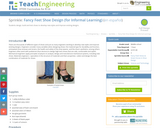
Students design, build and test shoes to develop new styles and improve existing designs.
- Subject:
- Engineering and Information Technologies
- Material Type:
- Lesson Plan
- Provider:
- TeachEngineering
- Provider Set:
- TeachEngineering
- Date Added:
- 10/14/2015

Students design, build and test shoes to develop new styles and improve existing designs.
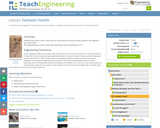
Students learn about fossils what they are, how they are formed, and why scientists and engineers care about them.

This project will be focused on designing, constructing and evaluating different containers to determine the optimal design for heat retention. After students have constructed their designs and collected and shared data, students will evaluate the class data to create an optimal design for our culminating event: warming ooey, gooey chocolate chip cookies to perfection! Through this activity, students will learn about energy transfer, engineering design process, data collection, graphing, rate of change, optimization, surface area and proportions. The students will test the effectiveness of their design using Vernier Probes to gather quantitative data and graphing the rate of temperature change. They will then create a poster presentation to share their data to the class. Students will use their mathematical skills to quantitatively analyze the strength and weaknesses of their designs while enjoying some delicious, toasty, warm cookies.
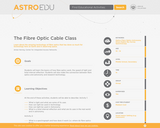
This activity is an interactive “out-of-the-seat” demo that allows the students to become involved in learning about fibre optic cables by imitating the way that one basically functions. While enjoying the physicality of the demo the children will pick up basic details of light, reflection, optical properties, and applications to technology. Additionally, the activity will go into details of how fibre optics are used in astronomy technology and how it is used to improve our understanding of the universe. An emphasis should be placed on asking direct questions to the children about how these concepts can influence technology, astronomy, and our world to reinforce the concepts that they are learning about.
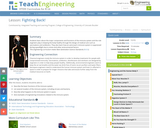
This lesson describes the major components and functions of the immune system and the role of engineers in keeping the body healthy (e.g., vaccinations and antibiotics, among other things). This lesson also discusses how an astronaut's immune system is suppressed during spaceflight due to stress and other environmental factors.
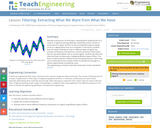
Filtering is the process of removing or separating the unwanted part of a mixture. In signal processing, filtering is specifically used to remove or extract part of a signal, and this can be accomplished using an analog circuit or a digital device (such as a computer). In this lesson, students learn the impact filtering can have on different types of signals, the concepts of frequency and spectrum, and the connections these topics have to real-world signals such as musical signals. Students also learn the roles that these concepts play in designing different types of filters. The lesson content prepares students for the associated activity in which they use an online demo and a variety of filters to identify the message in a distress signal heavily corrupted by noise.
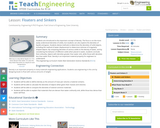
This lesson introduces students to the important concept of density. The focus is on the more easily understood densities of solids, but students can also explore the densities of liquids and gases. Students devise methods to determine the densities of solid objects, including the method of water displacement to determine volumes of irregularly-shaped objects. By comparing densities of various solids to the density of water, and by considering the behavior of different solids when placed in water, students conclude that ordinarily, objects with densities greater than water will sink, while those with densities less than water will float. Density is an important material property for engineers to understand.
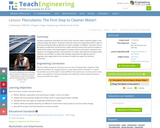
Students experience firsthand one of the most common water treatment types in the industry today, flocculants. They learn how the amount of suspended solids in water is measured using the basic properties of matter and light. In addition, they learn about the types of solids that can be found in water and the reasons that some are easier to remove than others. Encompassing the concepts of force and motion, attraction and repulsion of charged particles, and properties of matter, during the associated activity students see scientific concepts they already understand through the eyes of engineers who apply them to the removal of solids from water via chemical flocculants.
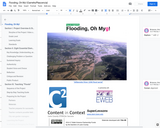
This is a 21 day unit on the topic of floods. Students will plan and prepare for what might happen in the event of a flood in our area. We have had floods in the past that have affected the Walterville School, its campus, and the surrounding areas. Using this as a springboard, students will discuss the effects of flooding, do research and interview family members who have experienced flooding, and then discuss possible ways to prevent significant damage on the buildings and surrounding areas. They will then design a barrier that could protect an area from damage for a period of time. Students will need materials to conduct experiments. We have listed these in the lesson plan. We have also included a trip to the Leaburg Dam so that students can learn about dams and their uses. We plan on teaching this unit in the fall.

In the Flow Rate Experiment, students perform hands-on experiments with a common faucet, as well as work with the Engineering Our Water Living Lab to gain a better understanding of flow rate and how it pertains to engineering and applied science. Students calculate the flow rate of a faucet for three different levels (quarter blast, half blast, and full blast). Building on these calculations, students hypothesize about the flow rate in a nearby river, and then use the Engineering Our Water Living Lab to check their hypothesis. For this lesson to be effective, your students need to have a visual feel for the flow in a nearby river.
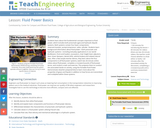
Students learn about the fundamental concepts important to fluid power, which includes both pneumatic (gas) and hydraulic (liquid) systems. Both systems contain four basic components: reservoir/receiver, pump/compressor, valve, cylinder. Students learn background information about fluid power—both pneumatic and hydraulic systems—including everyday applications in our world (bulldozers, front-end loaders, excavators, chair height lever adjustors, door closer dampers, dental drills, vehicle brakes) and related natural laws. After a few simple teacher demos, they learn about the four components in all fluid power systems, watch two 26-minute online videos about fluid power, complete a crossword puzzle of fluid power terms, and conduct a task card exercise. This prepares them to conduct the associated hands-on activity, using the Portable Fluid Power Demonstrator (teacher-prepared kits) to learn more about the properties of gases and liquids in addition to how forces are transmitted and multiplied within these systems.
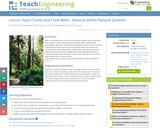
With a continued focus on the Sonoran Desert, students are introduced to the concepts of food chains and food webs through a PowerPoint® presentation. They learn the difference between producers and consumers and study how these organisms function within their communities as participants in various food chains. They further understand ecosystem differences by learning how multiple food chains link together to form intricate and balanced food webs. At lesson end, students construct food webs using endemic desert species.
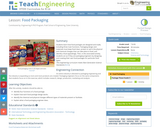
This lesson focuses on how food packages are designed and made. Students will learn three of the main functions of a food package. They will learn what is necessary of the design and materials of a package to keep food clean, protect or aid in the physical and chemical changes that can take place in a food, and identify a food appealingly. Then, in the associated activity, the students will have the opportunity to become packaging engineers by designing and building their own food package for a particular type of food.
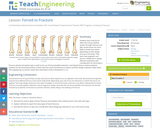
Students learn how forces affect the human skeletal system through fractures and why certain bones are more likely to break than others depending on their design and use in the body. They learn how engineers and doctors collaborate to design effective treatments with consideration for the location, fracture severity and patient age, as well as the use of biocompatible materials. Learning the lesson content prepares students for the associated activity in which they test small animal bones to failure and then design treatment repair plans.
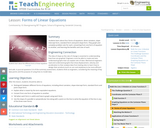
Students learn about four forms of equations: direct variation, slope-intercept form, standard form and point-slope form. They graph and complete problem sets for each, converting from one form of equation to another, and learning the benefits and uses of each.
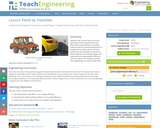
Students take a closer look at cars and learn about some characteristics that affect their energy efficiency, including rolling resistance and the aerodynamics of shape and size. They come to see how vehicles are one example of a product in which engineers are making changes and improvements to gain greater efficiency and thus require less energy to operate.
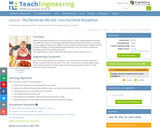
In this lesson, students will learn that minerals are a necessary part of our diet. They will learn that different minerals have different functions in the body. More specifically, they will discover that iron is necessary to carry oxygen around the body. In the associated activity, students will design a process that removes the most iron from the cereal.
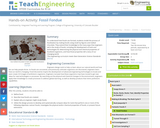
To understand how fossils are formed, students model the process of fossilization by making fossils using small toy figures and melted chocolate. They extend their knowledge to the many ways that engineers aid in the study of fossils, including the development of tools and technologies for determining the physical and chemical properties of fossilized organisms, and how those properties tell a story of our changing world.
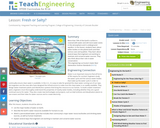
Between 70 and 75% of the Earth's surface is covered with water and there exists still more water in the atmosphere and underground in aquifers. In this lesson, students learn about water bodies on the planet Earth and their various uses and qualities. They will learn about several ways that engineers are working to maintain and conserve water sources. They will also think about their role in water conservation.
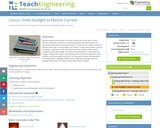
The lesson will first explore the concept of current in electrical circuits. Current will be defined as the flow of electrons. Photovoltaic (PV) cell properties will then be introduced. Generally constructed of silicon, photovoltaic cells contain a large number of electrons BUT they can be thought of as "frozen" in their natural state. A source of energy is required to "free" these electrons if we wish to create current. Light from the sun provides this energy. This will lead to the principle of "Conservation of Energy." Finally, with a basic understanding of the circuits through Ohm's law, students will see how the energy from the sun can be used to power everyday items, including vehicles. This lesson utilizes the engineering design activity of building a solar car to help students learn these concepts.